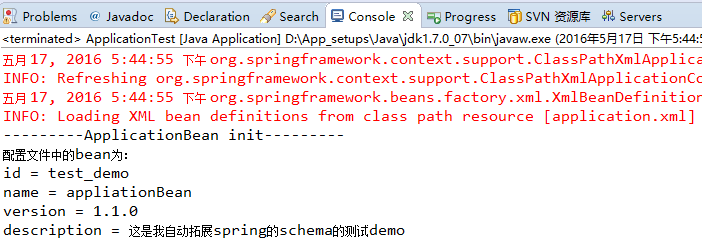一、背景
最近和朋友一起想開發一個類似alibaba dubbo的功能的工具,其中就用到了基於Spring的可擴充套件Schema進行開發自定義配置標籤支援,通過上網查資料自己寫了一個demo.今天在這裡進行和大家分享,也記錄下方便以後複習備忘。
二、demo測試環境
1.JDK1.7
2.spring 4.2.5.RELEASE
3.基於Maven
4.開發工具Eclipse
三、專案介紹
1.實現步驟分析
[1].設計配置屬性並開發JavaBean.
[2].編寫xsd檔案.
[3].編寫NamespaceHandler和BeanDefinitionParser完成解析工作.
[4].編寫spring.handlers和spring.schemas串聯起所有部件.
[5].編寫名為application.xml的spring配置檔案
[6].Maven Java專案的pom.xml.
[7].編寫測試類進行測試.
2.實現程式碼
[1].設計配置屬性並開發JavaBean程式碼(基於BaseBean進行定義)
BaseBean.java
1 package com.hafiz.zhang.tag.bean; 2 3 public interface BaseBean { 4 public abstract void init() throws Exception; 5 public abstract void destory(); 6 }
ApplicationBean.java
1 package com.hafiz.zhang.tag.bean; 2 3 public class ApplicationBean implements BaseBean { 4 private String id; 5 private String name; 6 private String version; 7 private String description; 8 public String getId() { 9 return id; 10 } 11 public void setId(String id) { 12 this.id = id; 13 } 14 public String getVersion() { 15 return version; 16 } 17 public void setVersion(String version) { 18 this.version = version; 19 } 20 public String getName() { 21 return name; 22 } 23 public void setName(String name) { 24 this.name = name; 25 } 26 public String getDescription() { 27 return description; 28 } 29 public void setDescription(String description) { 30 this.description = description; 31 } 32 33 @Override 34 public String toString() { 35 return "ApplicationBean [id=" + id + ", name=" + name + ", version=" + version + ", description=" + description 36 + "]"; 37 } 38 @Override 39 public void init() throws Exception { 40 System.out.println("---------ApplicationBean init---------"); 41 } 42 43 @Override 44 public void destory() { 45 System.out.println("---------ApplicationBean destory---------"); 46 } 47 48 }
[2].編寫xsd檔案.
hafiz.xsd(為上一步設計好的配置項編寫XSD檔案,XSD是schema的定義檔案,配置的輸入和解析輸出都是以XSD為契約,本例中XSD如下:)
1 <?xml version="1.0" encoding="UTF-8"?> 2 <xsd:schema 3 xmlns="http://www.hafiz.com/schema/hafiz" 4 xmlns:xsd="http://www.w3.org/2001/XMLSchema" 5 xmlns:beans="http://www.springframework.org/schema/beans" 6 targetNamespace="http://www.hafiz.com/schema/hafiz" 7 elementFormDefault="qualified" 8 attributeFormDefault="unqualified"> 9 <xsd:import namespace="http://www.springframework.org/schema/beans"/> 10 <xsd:element name="application"> 11 <xsd:complexType> 12 <xsd:complexContent> 13 <xsd:extension base="beans:identifiedType"> 14 <xsd:attribute name="name" type="xsd:string"/> 15 <xsd:attribute name="version" type="xsd:string"/> 16 <xsd:attribute name="description" type="xsd:string"/> 17 </xsd:extension> 18 </xsd:complexContent> 19 </xsd:complexType> 20 </xsd:element> 21 </xsd:schema>
注意:1.關於xsd:schema的各個屬性具體含義就不作過多解釋,可以參見http://www.w3school.com.cn/schema/schema_schema.asp.
2.<xsd:element name="application">對應著配置項節點的名稱,因此在應用中會用application作為節點名來引用這個配置.
3.<xsd:attribute name="name" type="xsd:string" />和<xsd:attribute name="version" type="xsd:string" />以及
<xsd:attribute name="description" type="xsd:string" />對應著配置項application的三個屬性名,因此在應用中可以配置name和version以及description三個屬性,都是string型別。
4.完成後需把xsd存放在classpath下,一般都放在META-INF目錄下(本例就放在這個目錄下)
[3].編寫NamespaceHandler和BeanDefinitionParser完成解析工作.
下面需要完成解析工作,會用到NamespaceHandler和BeanDefinitionParser這兩個概念。具體說來NamespaceHandler會根據schema和節點名找到某個BeanDefinitionParser,然後由BeanDefinitionParser完成具體的解析工作。因此需要分別完成NamespaceHandler和BeanDefinitionParser的實現類,Spring提供了預設實現類NamespaceHandlerSupport和BeanDefinitionParser,簡單的方式就是去繼承這兩個類。本例就是採取這種方式:
HafizNamespaceHandler.java
1 package com.hafiz.zhang.tag.handlers; 2 3 import org.springframework.beans.factory.xml.NamespaceHandlerSupport; 4 5 import com.hafiz.zhang.tag.bean.ApplicationBean; 6 import com.hafiz.zhang.tag.parser.ApplicationBeanDefinitionParser; 7 8 /** 9 * @author hafiz.Zhang 10 * @Date 2016年5月17日 下午12:22:57 11 * @Description 定義自定義的名稱空間hafiz處理器 12 */ 13 public class HafizNamespaceHandler extends NamespaceHandlerSupport { 14 15 @Override 16 public void init() { 17 //在這裡進行註冊自定義名稱空間 18 registerBeanDefinitionParser("application", new ApplicationBeanDefinitionParser(ApplicationBean.class)); 19 } 20 21 }
注:其中registerBeanDefinitionParser("application", new ApplicationBeanDefinitionParser());就是用來把節點名和解析類聯絡起來,在配置中引用application配置項時,就會用ApplicationBeanDefinitionParser來解析配置。
ApplicationBeanDefinitionParser.java
1 package com.hafiz.zhang.tag.parser; 2 3 import org.springframework.beans.factory.config.BeanDefinition; 4 import org.springframework.beans.factory.support.RootBeanDefinition; 5 import org.springframework.beans.factory.xml.BeanDefinitionParser; 6 import org.springframework.beans.factory.xml.ParserContext; 7 import org.springframework.util.StringUtils; 8 import org.w3c.dom.Element; 9 10 /** 11 * @author hafiz.Zhang 12 * @Date 2016年5月17日 下午12:27:12 13 * @Description 在這裡定義自定義名稱空間的bean解析器 14 */ 15 public class ApplicationBeanDefinitionParser implements BeanDefinitionParser { 16 17 private Class<?> clazz; 18 public ApplicationBeanDefinitionParser(Class<?> clazz) { 19 this.clazz = clazz; 20 } 21 @Override 22 public BeanDefinition parse(Element element, ParserContext parserContext) { 23 RootBeanDefinition rbd = new RootBeanDefinition(); 24 rbd.setBeanClass(clazz); 25 String id = element.getAttribute("id"); 26 String name = element.getAttribute("name"); 27 String version = element.getAttribute("version"); 28 String desc = element.getAttribute("description"); 29 if(StringUtils.hasText(id)) { 30 rbd.getPropertyValues().addPropertyValue("id", id); 31 } 32 if(StringUtils.hasText(name)) { 33 parserContext.getRegistry().registerBeanDefinition(name, rbd);//這句話非常重要,意思是基於名字進行把對應的bean載入到spring容器中 34 rbd.getPropertyValues().addPropertyValue("name", name); 35 } 36 if(StringUtils.hasText(version)) { 37 rbd.getPropertyValues().addPropertyValue("version", version); 38 } 39 if(StringUtils.hasText(desc)) { 40 rbd.getPropertyValues().addPropertyValue("description", desc); 41 } 42 rbd.setInitMethodName("init"); 43 rbd.setDestroyMethodName("destory"); 44 return rbd; 45 } 46 47 }
注:其中element.getAttribute就是用配置中取得屬性值,rbd.getPropertyValues().addPropertyValue就是把屬性值放到bean中。
[4].編寫spring.handlers和spring.schemas串聯起所有部件
上面幾個步驟走下來會發現開發好的handler與xsd還沒法讓spring容器感知到,就這樣放上去是沒法把前面做的工作納入體系中的,spring提供了spring.handlers和spring.schemas這兩個配置檔案來完成這項工作,這兩個檔案需要我們自己編寫並放入META-INF資料夾中,這兩個檔案的地址必須是META-INF/spring.handlers和META-INF/spring.schemas,spring會預設去載入它們,本例中spring.handlers如下所示:
1 http\://www.hafiz.com/schema/hafiz=com.hafiz.zhang.tag.handlers.HafizNamespaceHandler
以上表示當使用到名為"http://www.hafiz.com/schema/hafiz"的schema引用時,會通過com.hafiz.zhang.tag.handlers.HafizNamespaceHandler來完成解析.
spring.schemas如下所示:
1 http\://www.hafiz.com/schema/hafiz.xsd=META-INF/hafiz.xsd
以上就是載入xsd檔案。
注:以上兩個檔案中的"\"表示轉義。
[5].編寫名為application.xml的spring配置檔案
編寫application.xml檔案並放在classpath下,建議這樣做,但不是必須放在該位置。
1 <?xml version="1.0" encoding="UTF-8"?> 2 <beans xmlns="http://www.springframework.org/schema/beans" 3 xmlns:xsi="http://www.w3.org/2001/XMLSchema-instance" 4 xmlns:hafiz="http://www.hafiz.com/schema/hafiz" 5 xsi:schemaLocation=" 6 http://www.springframework.org/schema/beans 7 http://www.springframework.org/schema/beans/spring-beans-4.2.xsd 8 http://www.hafiz.com/schema/hafiz 9 http://www.hafiz.com/schema/hafiz.xsd"> 10 11 <hafiz:application id="test_demo" name="appliationBean" version="1.1.0" description="這是我自動擴充spring的schema的測試demo"/> 12 13 </beans>
其中xmlns:hafiz="http://www.hafiz.com/schema/hafiz"是用來指定自定義schema,xsi:schemaLocation用來指定xsd檔案。
<hafiz:application id="test_demo" name="applicationBean" version="1.1.0" description="這是我自動擴充spring的schema的測試demo"/>是一個具體的自定義配置使用例項.
注:此處的hafiz不是不能改變的,只要使用和上面指定的“xmlns:標籤名”的標籤名一樣就可以(程式碼加粗標黑處)。
[6].Maven Java專案的pom.xml.
在該檔案中主要引入spring的依賴
1 <project xmlns="http://maven.apache.org/POM/4.0.0" xmlns:xsi="http://www.w3.org/2001/XMLSchema-instance" 2 xsi:schemaLocation="http://maven.apache.org/POM/4.0.0 http://maven.apache.org/xsd/maven-4.0.0.xsd"> 3 <modelVersion>4.0.0</modelVersion> 4 5 <groupId>com.hafiz.zhang</groupId> 6 <artifactId>springTag</artifactId> 7 <version>0.0.1-SNAPSHOT</version> 8 <packaging>jar</packaging> 9 10 <name>springTag</name> 11 <url>http://maven.apache.org</url> 12 13 <properties> 14 <project.build.sourceEncoding>UTF-8</project.build.sourceEncoding> 15 <spring.version>4.2.5.RELEASE</spring.version> 16 </properties> 17 18 <dependencies> 19 <dependency> 20 <groupId>junit</groupId> 21 <artifactId>junit</artifactId> 22 <version>3.8.1</version> 23 <scope>test</scope> 24 </dependency> 25 <!-- springframework start --> 26 <dependency> 27 <groupId>org.springframework</groupId> 28 <artifactId>spring-core</artifactId> 29 <version>${spring.version}</version> 30 </dependency> 31 <dependency> 32 <groupId>org.springframework</groupId> 33 <artifactId>spring-context-support</artifactId> 34 <version>${spring.version}</version> 35 </dependency> 36 <!-- springframe end --> 37 </dependencies> 38 </project>
[7].編寫測試類進行測試.
1 package com.hafiz.zhang.test; 2 3 import org.springframework.context.ApplicationContext; 4 import org.springframework.context.support.ClassPathXmlApplicationContext; 5 6 import com.hafiz.zhang.tag.bean.ApplicationBean; 7 8 /** 9 * @author hafiz.Zhang 10 * @Date 2016年5月17日 下午2:01:37 11 * @Description 在此類中進行測試自定義擴充的schema 12 */ 13 public class ApplicationTest 14 { 15 private static ApplicationContext ac; 16 public static void main( String[] args ) 17 { 18 ac = new ClassPathXmlApplicationContext("application.xml"); 19 ApplicationBean bean = (ApplicationBean)ac.getBean("appliationBean"); 20 System.out.println( "配置檔案中的bean為:" ); 21 System.out.println( "id = " + bean.getId() ); 22 System.out.println( "name = " + bean.getName() ); 23 System.out.println( "version = " + bean.getVersion() ); 24 System.out.println( "description = " + bean.getDescription() ); 25 } 26 }
在控制檯會輸出:

附:專案結構圖

到此為止,spring的自定義標籤就已經實現了,歡迎大家進行交流學習~